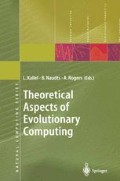Abstract
The first contribution of this paper is a theoretical investigation of a family of landscapes characterized by the number of their local optima N and the distribution of the sizes (α j ) of their attraction basins. For each landscape case, we give precise estimates of the size of the random sample that ensures that at least one point lies in each basin of attraction. A practical methodology is then proposed for identifying these quantities (N and (α j ) distribution) for an unknown landscape, given a random sample on that landscape and a local steepest ascent search. This methodology can be applied to any landscape specified with a modification operator and provides bounds on search complexity to detect all local optima. Experiments demonstrate the efficiency of this methodology for guiding the choice of modification operators, eventually leading to the design of problem-dependent optimnization heuristics.
Access this chapter
Tax calculation will be finalised at checkout
Purchases are for personal use only
Preview
Unable to display preview. Download preview PDF.
References
R. Azencott. Grandes déviations et applications. In P. L. Hennequin, editor, Proceedings of Ecole d’Eté de Probabilités de Saint-Flour. Springer-Verlag, Berlin Heidelberg New York, 1978.
S. Baluja. An empirical comparison of seven iterative and evolutionary function optimization heuristics. Technical Report CMU-CS-95–193, Carnegie Mellon University, 1995.
H. Cramer. Mathematical methods of statistics. Princeton University Press, Princeton, NJ, 1946.
D. B. Fogel and A. Ghozeil. Using fitness distributions to design more efficient evolutionary computations. In T. Fukuda, editor, Proceedings of the Third IEEE International Conference on Evolutionary Computation, pages 11–19. IEEE, New York, 1996.
D. E. Goldberg. Genetic algorithms in search, optimization and machine learning. Addison-Wesley, Englewood Cliffs, NJ, 1989.
J. H. Holland. Adaptation in natural and artificial systems. University of Michigan Press, Ann Arbor, MI, 1975.
T. Jones and S. Forrest. Fitness distance correlation as a measure of problem difficulty for genetic algorithms. In L. J. Eshelman, editor, Proceedings of the 6th International Conference on Genetic Algorithms, pages 184–192. Morgan Kaufmann, San Francisco, 1995.
L. Kallel. Convergence des algorithmes génétiques: aspects spatiaux et temporels. PhD thesis, Ecole Polytechnique, Palaiseau, France, 1998.
L. Kallel, B. Naudts, and M. Schoenauer. On functions with a fixed fitness distance relation. Technical Report 399, CMAP, Ecole Polytechnique, Palaiseau, France, 1998.
L. Kallel and M. Schoenauer. Alternative random initialization in genetic algorithms. In T. Bäck, editor, Proceedings of the 7th International Conference on Genetic Algorithms, pages 268–275. Morgan Kaufmann, San Francisco, 1997.
L. Kallel and M. Schoenauer. A priori predictions of operator efficiency. In J.-K. Hao, E. Lutton, E. Ronald, M. Schoenauer, and D. Snyers, editors, Artificial Evolution’97, LNCS. Springer-Verlag, Berlin Heidelberg New York, 1997.
P. Stadler. Towards a theory of landscapes. In R. Lopèz-Pena, R. Capovilla, R. Garcia Pelayo, H. Waelbroeck, and F. Zertouche, editors, Complex systems and binary networks, pages 77–163. Springer-Verlag, Berlin Heidelberg New York, 1995.
B. Manderick, M. de Weger, and P. Spiessens. The genetic algorithm and the structure of the fitness landscape. In R. K. Belew and L. B. Booker, editors, Proceedings of the 4th International Conference on Genetic Algorithms, pages 143–150. Morgan Kaufmann, San Francisco, 1991.
P. Merz and B. Freisleben. Memetic algorithms and the fitness landscape of the graph bi-partitioning problem. In A. E. Eiben, T. Bäck, M. Schoenauer, and H.-P. Schwefel, editors, Proceedings of the 4th Conference on Parallel Problems Solving from Nature, volume 1498 of LNCS, pages 765–774. Springer-Verlag, Berlin Heidelberg New York, 1998.
C. H. Papadimitriou and K. Steiglitz. Combinatorial optimization: Algorithms and complexity. Prentice-Hall, Englewoods Cliffs, NJ, 1982.
C. A. Tovey. Local improvement on discrete structures. In E. Aarts and J. K. Lenstra, editors, Local search and combinatorial optimization. John Wiley, New York, 1997.
C. A. Tovey. Hill climbing with multiple local optima. SIAM J. Alg. Disc. Math., 6:384–393, 1985.
G. Parisi, M. Mezard, and M. A. Virasoro. Spin glass theory and beyond. World Scientific, 1987.
R. Pyke. Spacings. J. Roy. Statis. Soc., 27:395–436, 1965.
R. J. Quick, V. J. Rayward-Smith, and G. D. Smith. Fitness distance correlation and ridge functions. In A. E. Eiben, T. Bäck, M. Schoenauer, and H.-P. Schwefel, editors, Proceedings of the 4th Conference on Parallel Problems Solving from Nature, volume 1498 of LNCS, pages 77–86. Springer-Verlag, Berlin Heidelberg New York, 1998.
R. Rammal, G. Toulouse and M. A. Virasoro. Ultrametricity for Physicists. Reviews of Modern Physics 58:765–788, 1986.
S. Rochet, G. Venturini, M. Slimane, and E. M. El Kharoubi. A critical and empirical study of epistasis measures for predicting GA performances: A summary. In J.-K. Hao, E. Lutton, E. Ronald, M. Schoenauer, and D. Snyers, editors, Artificial Evolution’97, LNCS, pages 287–299. Springer-Verlag, Berlin Heidelberg New York, 1997.
V. Slavov and N. I. Nikolaev. Genetic algorithms, fitness sublandscapes and subpopulations. In W. Banzhaf and C. R. Reeves, editors, Foundations of Genetic Algorithms 5, pages 199–218. Morgan Kaufmann, San Francisco, 1999.
P. Stadler. Landscapes and their correlation functions. J. Math. Chem., 20:1–45, 1996.
P. J. van Laarhoven and E. H. L. Aarts. Simulated Annealing: Theory and Applications. Kluwer Academic, Dordrecht, The Netherlands, 1987.
E. D. Weinberger. Correlated and uncorrelated fitness landscapes and how to tell the difference. Biological Cybernetics, 63:325–336, 1990.
G. B. Wetherill. Elementary statistical methods. Chapman and Hall, London, 1972.
S. S. Wilks. Mathematical statistics. John Wiley, New York, 1962.
Author information
Authors and Affiliations
Editor information
Editors and Affiliations
Rights and permissions
Copyright information
© 2001 Springer-Verlag Berlin Heidelberg
About this chapter
Cite this chapter
Garnier, J., Kallel, L. (2001). How to Detect all Maxima of a Function. In: Kallel, L., Naudts, B., Rogers, A. (eds) Theoretical Aspects of Evolutionary Computing. Natural Computing Series. Springer, Berlin, Heidelberg. https://doi.org/10.1007/978-3-662-04448-3_17
Download citation
DOI: https://doi.org/10.1007/978-3-662-04448-3_17
Publisher Name: Springer, Berlin, Heidelberg
Print ISBN: 978-3-642-08676-2
Online ISBN: 978-3-662-04448-3
eBook Packages: Springer Book Archive

